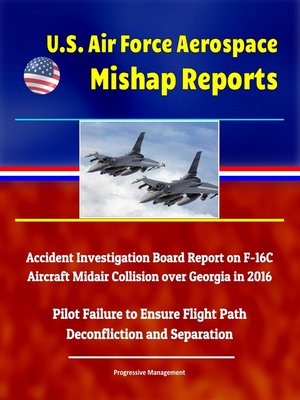U.S. Air Force Aerospace Mishap Reports
ebook ∣ Accident Investigation Board Report on F-16C Aircraft Midair Collision over Georgia in 2016--Pilot Failure to Ensure Flight Path Deconfliction and Separation

Sign up to save your library
With an OverDrive account, you can save your favorite libraries for at-a-glance information about availability. Find out more about OverDrive accounts.
Find this title in Libby, the library reading app by OverDrive.



Search for a digital library with this title
Title found at these libraries:
| Library Name | Distance |
|---|---|
| Loading... |
This Air Force accident report has been professionally converted for accurate flowing-text e-book format reproduction. Two F-16Cs collided head-on and crashed during training at Bulldog Military Operation Area near Louisville, Georgia., June 7, 2016, after a pilot failed to ensure flight path deconfliction and separation of aircraft, according to the Air Combat Command Accident Investigation Board report. Both pilots were unable to regain control of their aircraft and ejected shortly after the collision sustaining minor injuries. Both aircraft were destroyed after impacting the ground in a rural area, damaging private property. The mishap occurred during a night training sortie, while the aircraft were operating in a visual wedge formation.
At approximately 9:13 p.m., pilot two radioed that his aircraft had reached a low fuel level that required training termination and an immediate return to the base. After this radio transmission, pilot one did not call "Knock it off" to terminate tactical maneuvering for all aircraft that were part of the training, and began an unannounced left turn to rejoin the second aircraft to return to base. At the same time, pilot two had already begun to follow the first aircraft's external lights using visual cues, but did not cross-check available sensors to confirm pilot one's position. Pilot two did not realize that pilot one was heading directly towards him and pointed directly at the first aircraft's external lights in an attempt to acquire a visual mode radar lock while descending from his sanctuary altitude. The second pilot acquired radar lock with 2,500 feet separation, but still did not recognize the conflict. At the last fraction of a second, both aircraft initiated a left bank away from the other and their high right wings collided. The Board President concluded the cause of the mishap was pilot two's failure to fulfill his primary responsibility to ensure flight path deconfliction and separation of aircraft. Additionally, the AIB found two contributing factors to the mishap. The first contributing factor was that the first pilot did not terminate tactical maneuvering following pilot two's low fuel call. The second contributing factor was that both pilots overly relied on visual cues from external aircraft lighting to judge critical flight parameters.







